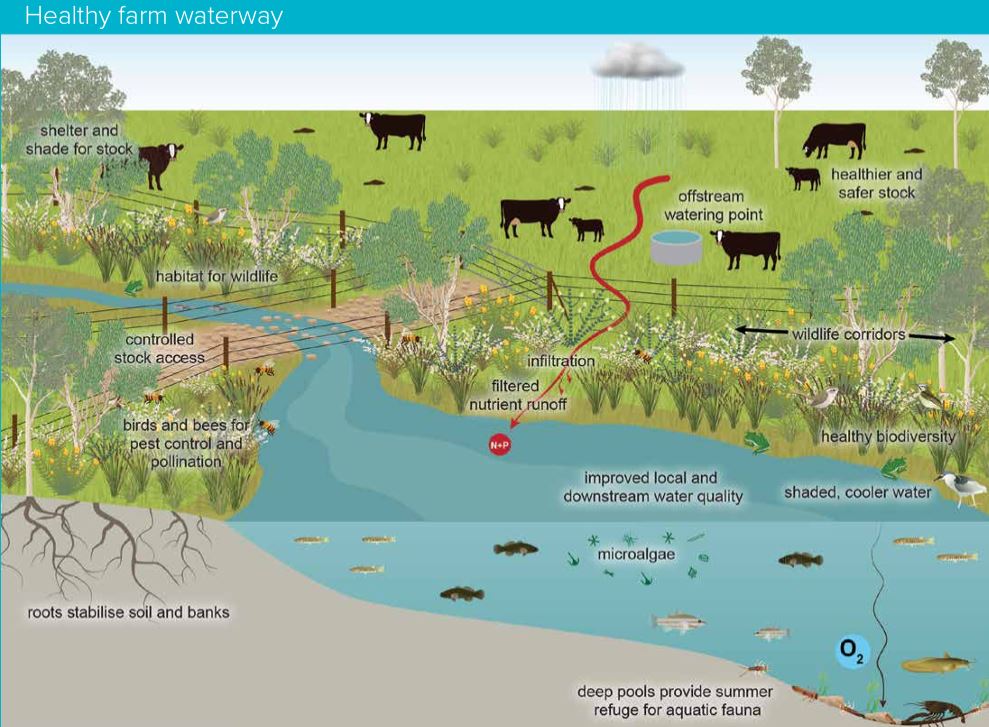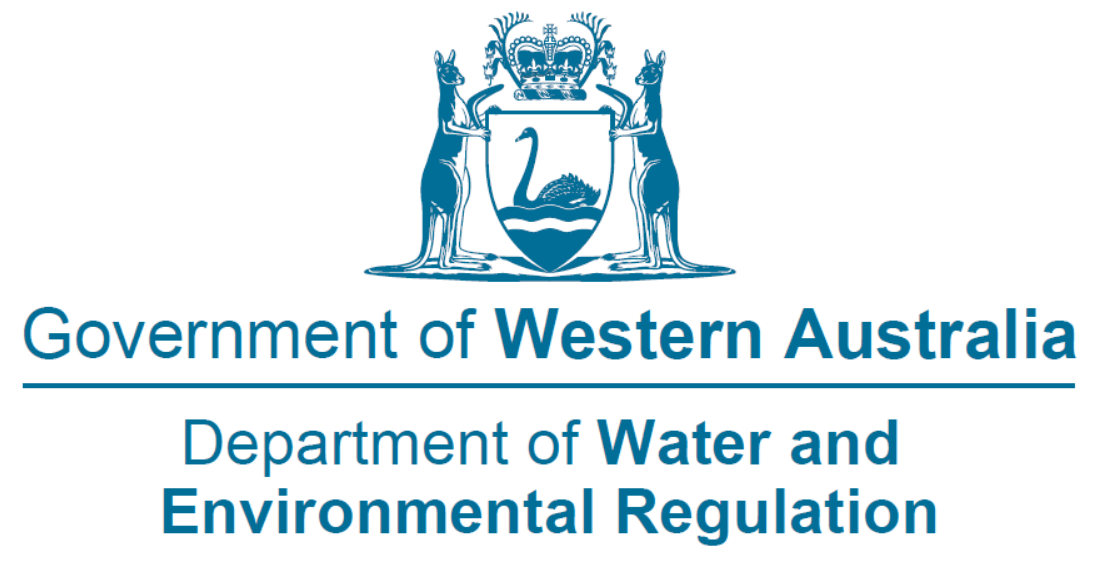
Revegetation can benefit your land and your catchment in numerous ways depending on how they are planted. There are however some golden rules to a successful ecological revegetation no matter the aim:
Why is revegetation important?
Windbreak
A good windbreak can slow wind speed up to 80% this can benefit landholders by limiting crop and pasture moisture loss and stock stress. Although the trees take up land and resources though they shelter a much larger area and the benefits far outweigh these losses.
Some design tips include:
Wildlife Habitat Corridors
Native vegetation can be planted to provide habitat for wildlife and assist wildlife movements across the landscape by connecting patches of remnant bushland.
Some design tips include:
Riparian buffer
Planting alongside watercourses in the ‘riparian zone’ can provide important habitat for wildlife and help to improve water quality by filtering sediment and nutrients from the surrounding landscape. This is most effective if close to 100% groundcover is maintained via fencing of stock.
Some design tips include:
Screening
Trees and shrubs may be used as visual barriers to block a view, noise screens that reflect back offending noise or as buffers to filter spray drift from adjacent activities such as intensive cropping or horticulture.
Some design tips include:
- Most effective when biodiverse in species and structure.
- Must control weeds before and during the sites establishment
- Use locally occurring plants, native to your area
Why is revegetation important?
Windbreak
A good windbreak can slow wind speed up to 80% this can benefit landholders by limiting crop and pasture moisture loss and stock stress. Although the trees take up land and resources though they shelter a much larger area and the benefits far outweigh these losses.
Some design tips include:
- Best results are achieved when the windbreak is perpendicular (at right angles) to the problem wind. If it’s practical and the risk of localised frost is low consider planting your windbreak in a curve, such as along an elevation contour, so there is always a portion of the break perpendicular to the wind.
- A good windbreak should be around 40% porous, sparse enough to encourage the wind to flow through but dense enough to offer resistance and slow down the air speed.
- Give your plants room to grow—a minimum of 25m for a four row break. Tall, bushy plants cannot be achieved if plants are packed like soldiers on parade.
- Plant the outside rows with shrub species. This will provide low foliage cover and reduce the moisture and nutrient robbing effect of large trees on adjacent pastures and crops.
- Try to avoid gaps and short windbreaks as wind can deflect around the ends of the windbreak and increase wind turbulence. A windbreak with holes is ineffective and may even cause wind tunneling (a localised increase in wind speed).
Wildlife Habitat Corridors
Native vegetation can be planted to provide habitat for wildlife and assist wildlife movements across the landscape by connecting patches of remnant bushland.
Some design tips include:
- To be effective, wildlife corridors should connect at least two patches of remnant vegetation. Try to avoid gaps that include barriers such as roads, which can inhibit the movements of small mammals.
- It’s a good idea to plant alongside remnant vegetation such as travelling stock reserves, roadsides or creeks as wildlife will be able to immediately use your revegetation site and plants from the remnant area and may naturally regenerate in the revegetation site, improving the complexity.
- Habitat corridors are most effective when biodiverse in species and structure.
- Incorporate other habitat features into your site such as mature paddock trees, rocky outcrops and fallen timber. These features will greatly increase habitat diversity.
- The wider, the better. This creates a ‘core’ area that is free from edge effects and will provide habitat, rather than just a corridor for wildlife movement. Wide corridors, greater than 30m, may be used by less common wildlife (declining species) and narrow corridors are often dominated by common, aggressive birds etc.
- Consider putting curves in your rows
Riparian buffer
Planting alongside watercourses in the ‘riparian zone’ can provide important habitat for wildlife and help to improve water quality by filtering sediment and nutrients from the surrounding landscape. This is most effective if close to 100% groundcover is maintained via fencing of stock.
Some design tips include:
- In general, the wider the buffer zone, the better. The recommended minimum width for most small creeks and drainage lines is an average of 20m either side of the water course with give-and-take, to account for bends in the course of the creek, though any buffer is better than no buffer at all.
- No trees or shrubs should be planted in the channel or main water flow area as if these plant survive they could obstruct the flow of water and cause erosion.
- Site preparation should be kept to a minimum and timed appropriately to reduce the risk of erosion. The use of chemicals to control weeds should also be minimised and must comply with relevant regulations.
- Any woody weeds such as Sydney Golden wattle should be treated prior to any new vegetation being planted.
- Plant reproductive material (such as seeds and root suckers) may be easily transported downstream so it is very important to only use locally occurring plants, native to your area.
- The site needs to be fenced to protect the vegetation from stock,
- Due to the need to retain groundcover and minimise site disturbance, the use of spot planting techniques (using seedlings or seed) is recommended.
Screening
Trees and shrubs may be used as visual barriers to block a view, noise screens that reflect back offending noise or as buffers to filter spray drift from adjacent activities such as intensive cropping or horticulture.
Some design tips include:
- Visual screen: structure like a windbreak with the outside rows planted with shrubs to produce a low hedge-like cover.
- Noise screens: you should use a mix of trees and shrubs along your row to ensure good foliage cover from ground to tree height. The wider the planting, the better—ideally aim for a minimum width of 30m or three widely spaced rows.
- Spray drift buffers; these planting need to be approximately 30 to 50% porous and consist of a large variety of foliage types (fine to coarse foliage). This maximises the filtration of airborne particles. The wider the buffer, the better (a minimum suggested width is 40m). Buffers also need to be as close as practical to the spray source—the further away, the less effective.
Planning
It is important to carefully plan your revegetation project, taking into consideration what you aim to achieve with your planting, where you will be planting, what species you will plant and how you will plant them.
Once you have completed a detailed plan for the revegetation project, you will know what materials, plants, equipment and labour will be required to complete the planting so that you can accurately cost your project. Please contact us if you'd like help with this.
It is important to carefully plan your revegetation project, taking into consideration what you aim to achieve with your planting, where you will be planting, what species you will plant and how you will plant them.
Once you have completed a detailed plan for the revegetation project, you will know what materials, plants, equipment and labour will be required to complete the planting so that you can accurately cost your project. Please contact us if you'd like help with this.
Sources
| national_restoration_standards.pdf | |
| File Size: | 2218 kb |
| File Type: | |
| iucn_wildlife_corridors.pdf | |
| File Size: | 6524 kb |
| File Type: | |
| Albany_Regional_veg_survey_final_report_24aug2010.pdf | |
| File Size: | 55714 kb |
| File Type: | |
If you live between the Porongurup Range and Stirling Ranges see these documents might interest you
| rangeslinkcapbooklet.pdf | |
| File Size: | 1777 kb |
| File Type: | |
| rangeslinkvegsurvey_2016_17_final.pdf | |
| File Size: | 9110 kb |
| File Type: | |
We acknowledge the Minang and Koreng people as the traditional custodians of the land on which we work and live. We pay our respects to the Elders, past, present, and emerging and to the wider Noongar community.
Sponsors and Supporters











